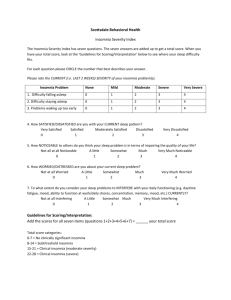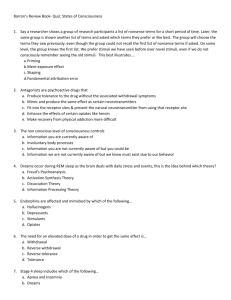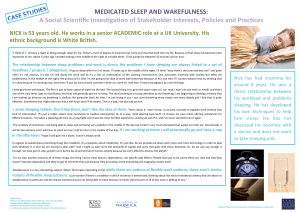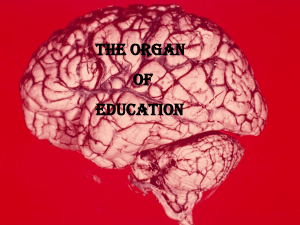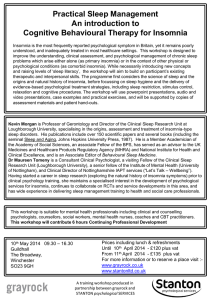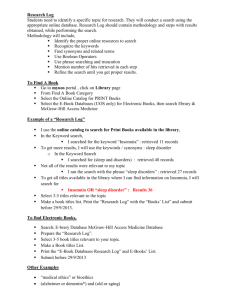Treating Insomnia in General Practice Mark Camilleri Case Presentation
advertisement
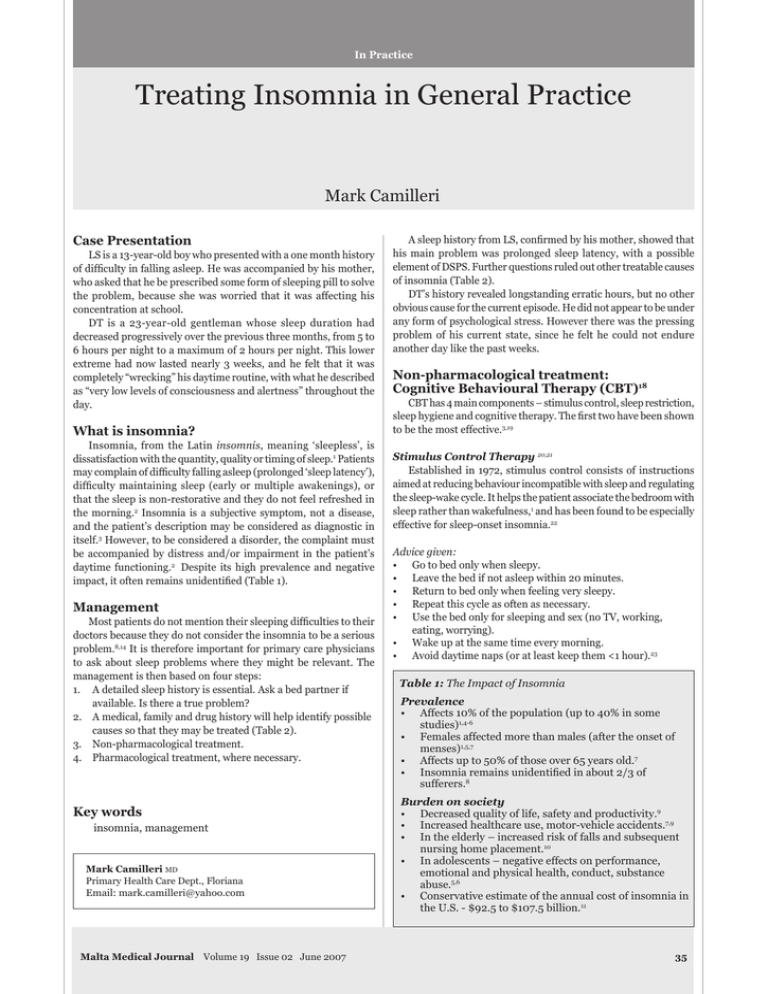
In Practice Treating Insomnia in General Practice Mark Camilleri Case Presentation LS is a 13-year-old boy who presented with a one month history of difficulty in falling asleep. He was accompanied by his mother, who asked that he be prescribed some form of sleeping pill to solve the problem, because she was worried that it was affecting his concentration at school. DT is a 23-year-old gentleman whose sleep duration had decreased progressively over the previous three months, from 5 to 6 hours per night to a maximum of 2 hours per night. This lower extreme had now lasted nearly 3 weeks, and he felt that it was completely “wrecking” his daytime routine, with what he described as “very low levels of consciousness and alertness” throughout the day. What is insomnia? Insomnia, from the Latin insomnis, meaning ‘sleepless’, is dissatisfaction with the quantity, quality or timing of sleep.1 Patients may complain of difficulty falling asleep (prolonged ‘sleep latency’), difficulty maintaining sleep (early or multiple awakenings), or that the sleep is non-restorative and they do not feel refreshed in the morning.2 Insomnia is a subjective symptom, not a disease, and the patient’s description may be considered as diagnostic in itself.3 However, to be considered a disorder, the complaint must be accompanied by distress and/or impairment in the patient’s daytime functioning.2 Despite its high prevalence and negative impact, it often remains unidentified (Table 1). Management Most patients do not mention their sleeping difficulties to their doctors because they do not consider the insomnia to be a serious problem.8,14 It is therefore important for primary care physicians to ask about sleep problems where they might be relevant. The management is then based on four steps: 1. A detailed sleep history is essential. Ask a bed partner if available. Is there a true problem? 2. A medical, family and drug history will help identify possible causes so that they may be treated (Table 2). 3. Non-pharmacological treatment. 4. Pharmacological treatment, where necessary. Key words insomnia, management Mark Camilleri MD Primary Health Care Dept., Floriana Email: mark.camilleri@yahoo.com Malta Medical Journal Volume 19 Issue 02 June 2007 A sleep history from LS, confirmed by his mother, showed that his main problem was prolonged sleep latency, with a possible element of DSPS. Further questions ruled out other treatable causes of insomnia (Table 2). DT’s history revealed longstanding erratic hours, but no other obvious cause for the current episode. He did not appear to be under any form of psychological stress. However there was the pressing problem of his current state, since he felt he could not endure another day like the past weeks. Non-pharmacological treatment: Cognitive Behavioural Therapy (CBT)18 CBT has 4 main components – stimulus control, sleep restriction, sleep hygiene and cognitive therapy. The first two have been shown to be the most effective.3,19 Stimulus Control Therapy 20,21 Established in 1972, stimulus control consists of instructions aimed at reducing behaviour incompatible with sleep and regulating the sleep-wake cycle. It helps the patient associate the bedroom with sleep rather than wakefulness,1 and has been found to be especially effective for sleep-onset insomnia.22 Advice given: • Go to bed only when sleepy. • Leave the bed if not asleep within 20 minutes. • Return to bed only when feeling very sleepy. • Repeat this cycle as often as necessary. • Use the bed only for sleeping and sex (no TV, working, eating, worrying). • Wake up at the same time every morning. • Avoid daytime naps (or at least keep them <1 hour).23 Table 1: The Impact of Insomnia Prevalence • Affects 10% of the population (up to 40% in some studies)1,4-6 • Females affected more than males (after the onset of menses)1,5,7 • Affects up to 50% of those over 65 years old.7 • Insomnia remains unidentified in about 2/3 of sufferers.8 Burden on society • Decreased quality of life, safety and productivity.9 • Increased healthcare use, motor-vehicle accidents.7,9 • In the elderly – increased risk of falls and subsequent nursing home placement.10 • In adolescents – negative effects on performance, emotional and physical health, conduct, substance abuse.5,6 • Conservative estimate of the annual cost of insomnia in the U.S. - $92.5 to $107.5 billion.11 35 Sleep Restriction Therapy 15,21 In use since 1987, the aim here is to constrict the time spent in bed to the actual time spent asleep. A sleep diary is kept for circa two weeks to establish the average sleep duration. The patient is then only allowed to stay in bed for that amount of time (but ideally not less than 5 hours20). This may initially cause daytime sleepiness, but the time window is gradually increased over a number of weeks until adequate sleep duration is achieved. • Exercise Exercise regularly, but not during the 3-4 hours before bedtime (except for sex).7,13 Exercising may be the most costeffective health intervention for insomniacs,1 and has been shown to be as effective as drug treatment (benzodiazepines) in improving sleep quality and duration.1,24 • Relaxation Relaxation techniques before bedtime help reduce muscular and mental tension, arousal, and anxiety. They may involve meditation, progressive muscle relaxation, a warm bath, or simply a ‘winding-down’ routine such as reading. Patients may learn techniques from audiotapes, classes, or physiotherapists.7 Relaxation is especially helpful in young adults.13 Sleep Hygiene This involves educating the patient about the effects of lifestyle on sleep. Handouts23 help supplement verbal advice and improve patient compliance. Advice given: • Stick to a regular bedtime and waking time.23 • Avoid caffeine, nicotine and alcohol during the 6 hours before bedtime (but a ‘nightcap’ might help).13 • Avoid large meals close to bedtime (but a light snack might help).13 • Decrease evening fluid intake (but a warm, milky drink might help).7 • Remove any clocks from sight in the bedroom.13 • Ensure that the bedroom temperature is comfortable. Cognitive Therapy During cognitive therapy sessions insomniacs are taught to correct any wrong assumptions or perceptions they might have about sleep (e.g. ‘we all need 8 hours of sleep’), which may be causing anxiety and worsening the problem.21,25 Cognitive therapy also seeks to enhance one’s ability to cope with the stresses which contribute to insomnia,17 as well as reassuring the elderly about their natural and expected changes in sleeping patterns.21 Table 2: Causes of Insomnia 1. Transient Insomnia 7,12 A few days of insomnia in someone who normally sleeps well. a. Environmental Factors e.g. noise, temperature extremes, shift work, jet-lag b. Life events e.g. upcoming surgery, job stress, exams, deadlines, travel 2. Short-term Insomnia 12 >1 week but <6 months of insomnia a. Prolongation of transient factors listed above b. Significant losses (bereavement, separation) c. Major illness in loved ones d. Parents with babies e. Pregnancy (hormonal changes, worries, physical discomfort) 7 3. Chronic Insomnia >6 months of insomnia a. Medical Disorders1,7,13,14 Chronic pain of any cause (e.g. arthritis, cancer) Respiratory impairment of any cause (e.g. congestive heart failure) Gastrointestinal (e.g. heartburn, constipation) Neurological (e.g. Alzheimer’s, movement disorders, headache syndromes) Hypertension, Urinary symptoms, Pruritus, Tinnitus, Perimenopause b. Drugs Diuretics,15 bronchodilators,16 H2 antagonists,13 betaadrenoceptor-blockers,12 thyroxine,12 chemotherapy,10 alcohol,12,15, steroids,7 decongestants,16 stimulants (caffeine, nicotine, diet pills10) psychotropics,1 anti-depressants,16 anti-parkinsonians.15 36 c. Psychiatric and Psychological Disorders 1,5 Anxiety, Depression, Mania, Schizophrenia, Dementia, Substance abuse d. Primary Sleep Disorders 12 Obstructive sleep apnoea (refer to specialist or sleep clinic) Restless Legs Syndrome (RLS or ‘Ekbom’s syndrome’) Narcolepsy Circadian rhythm disturbances: i. Shift-work ii. Delayed sleep phase syndrome (DSPS) 5 Often seen in younger patients – lifestyle change towards a later bedtime which, when coupled with early waking times imposed by school or work, results in less sleep. Often identified because the patient has difficulty waking, and sleeps normal hours on weekends. iii.Advanced sleep phase syndrome (ASPS) 5,13 Often seen in elderly patients – lifestyle change towards earlier bedtime, sometimes due to fatigue, with accompanying very early awakenings. They may find it difficult to stay awake to a more socially acceptable bedtime. However, the patient is in fact sleeping an adequate number of hours, and reassurance is often all that is necessary. e. Primary Insomnia Psycho-physiological Insomnia (most cases): The patient responds to a prolonged period of stress with somatised tension and agitation, causing physiological arousal. This causes the sleep routine to be associated with frustration and arousal, and perpetuates the period of insomnia beyond the period of stress. In some primary insomniacs this may be due to inefficient coping mechanisms – patients experience a normal amount of daily, minor stresses, but they perceive the impact as greater, and cope by seeking to lessen the emotional distress rather than solve the problem. 14,17 Malta Medical Journal Volume 19 Issue 02 June 2007 Does it work? Is it enough? CBT is practical and easily understood, and therefore appealing to patients. It also causes minimal side effects.19,26 More importantly, there is a constantly growing evidence-base for its effectiveness. Numerous recent studies have shown that CBT is effective and superior to placebo,20,26 and comparable with or better than pharmacological treatment (hypnotics) in the short-term.19,22,24,27 In the long-term, CBT has been shown to give lasting improvements in sleep quality,3,19,22,24 with better results than hypnotics.24,27 Other studies showed CBT to be suitable and effective in children,6 the elderly,19,24 and patients with insomnia secondary to chronic pain.25 Patient preference is also greater than for hypnotics,24 and CBT use has been shown to decrease hypnotic use, cost, and utilisation of primary healthcare services in the long-term.22 What are its limitations? CBT, especially the Cognitive Therapy component, is a time consuming treatment which may require referral to a trained therapist. Typical courses may involve 4-8 weekly sessions of up to an hour each, and therefore substantial patient motivation is needed.19,22 The use of CBT is also limited due to initial costs (and variable insurance reimbursements), lack of trained providers, and poor understanding of what it entails.4,24 Patients may also assume that hypnotics are more effective.19 However, if it is possible to set some time aside, GPs can deliver a large proportion of the appropriate advice and education,4,22 and CBT has been shown to eventually decrease the burden on the GP, despite the initial extra effort and time required.29 GPs are also ideally placed to offer ongoing advice and encouragement during follow-up. Pharmacological Treatment Hypnotics are drugs that induce sleep, and it must therefore be noted that they are relieving the symptom, not treating the underlying cause.4 Possible indications for pharmacotherapy: 1. Transient/short term insomnias Only 1 or 2 doses, and ideally a drug that is quickly eliminated from the body, in order to minimize residual effects.12,30 2. Primary insomnia e.g. If the patient will benefit from the more rapid effects of drug therapy, until the longer-lasting benefits of CBT take effect. This also helps prevent untreated short-term insomnia from becoming chronic.13 3. Secondary insomnia due to medical or psychiatric disorders.30 4. Occasional use in children with night terrors or somnambulism.12 Sedating Antihistamines (e.g. Diphenhydramine) Most over-the-counter hypnotics contain sedating antihistamines, which are effective at inducing drowsiness. However, their sedative effects diminish after a few days of continuous treatment.12 Their half-life is up to 8 hours, resulting in residual sedation the next day, besides various other side-effects.10 40% of insomniacs resort to self-medication with over-thecounter preparations, alcohol, or both.4,8 Neither has been proven to be any better than placebo when weighing risks versus benefits.1 38 Alcohol It is no secret that alcohol induces drowsiness, however it causes restless sleep and its diuretic effect interferes with sleep during the latter part of the night.12 It should also be discouraged because of its abuse potential. Herbal Remedies (usually containing Valerian Root) Valerian root has sedative effects and has been shown to be superior to placebo for improving sleep quality. It is useful for mild, short-term insomnia; however its long-term effects and effectiveness are as yet unproven. It causes mild but common side effects such as headache, nausea and residual sleepiness, and is costly for patients since it is not available on government formularies.31,32 Melatonin Melatonin is a neurohormone which is secreted by the pineal gland at night and suppressed by light, and thereby regulates circadian rhythms.13 The evening rise precedes sleepiness by around 90-120 minutes. Giving melatonin helps decrease sleep latency, but has not produced consistent results with other sleep variables.33 Although shown to be safe for short-term use,9 it may worsen asthma and epilepsy,33 and cannot be recommended since it is unknown whether long-term use is safe or whether it suppresses endogenous production.3,33 Benzodiazepines (BDZs) Introduced in the 1960s, BDZs enhance the effect of GammaAminobutyric acid (GABA), which is the major inhibitory neurotransmitter in the central nervous system.4 They therefore have hypnotic, anxiolytic, anticonvulsant and muscle-relaxant properties.13 They bring about statistically significant improvements in sleep variables.13,28 BDZs commonly cause headache, drowsiness, dizziness, rebound insomnia (even after just one night of use), residual sedation, respiratory depression, anterograde amnesia and memory loss.12-14 Users may develop tolerance within 3-14 days of continuous use,12 which may lead to abuse.4,14 It is estimated that 10-30% of chronic users are physically and/or psychologically dependent, and 50% of users suffer withdrawals after stopping the drug.4 BDZ use also increases the risk of motor-vehicle accidents and falls leading to femur fractures.1,10 There is virtually no evidence to support the chronic use of BDZs for insomnia, since despite all the adverse effects listed above, longterm clinical benefits are modest at best.4,12,22,28 In view of the above, the Committee on Safety of Medicines 12 advises that BDZs should only be used in insomnia when it is ‘severe, disabling, or subjecting the individual to extreme distress’. One should aim for intermittent use, and the lowest effective dose. Even then, use should never exceed 3 weeks in duration (preferably 1 week), and a rapidly-eliminated drug should be used.12 Despite all this evidence of major harm, BZD prescribing continues to grow, and patient satisfaction remains high, despite adverse effects.15 They remain common in the primary care setting,22 with over two thirds of users having been started on the drug by their family doctor.34 One need only pay a short visit to one of the local prescription clinics in the Primary Health Care Department to see ample evidence of widespread long-term use, even amongst the frail and elderly. It is estimated that chronic users make up around 2% of the population.34 Malta Medical Journal Volume 19 Issue 02 June 2007 Z-Drugs (Zolpidem [Stilnox®], Zopiclone, Zaleplon) Developed in the 1980s, Z-Drugs differ structurally from BDZs but are also GABA-agonists. Although initially championed as having lesser side effects, there is lack of compelling evidence to distinguish between them and the shorter-acting BDZs with regards to effectiveness, adverse effects or potential for dependence.4,10 The UK’s National Institute for Clinical Evidence (NICE) therefore advises that one simply choose the cheaper drug, and that one switches from a BDZ to a Z-Drug only if there is a complaint of adverse effects.4 A 15-20 minute discussion about sleep hygiene with LS and his mother brought out several possible improvements in his lifestyle and sleep routine. A list of changes was drawn up, and he agreed to put them into practice over the following weeks. It was also explained to the mother why drug treatment was not indicated. He did not return for follow-up, but during a non-related visit by his mother a few months later she confirmed that the problem had resolved. DT was prescribed a short-acting BDZ for 2 weeks, during which he managed to sleep better, and his daytime functioning improved. He then stopped the hypnotics, and experienced three days of rebound insomnia, which he had been warned about, but his sleeping then improved. In the meantime, he had slowly started implementing various behavioural modifications. At follow-up visits he reported an improved overall sleep duration, and ‘improved capacity to handle stress and pressure’, which he felt had a direct effect on his sleeping. Over the following year he maintained an average of 5 hours of sleep per night, but more importantly he now feels that his daytime functioning has returned to normal. References 1. Holbrook AM, Crowther R, Lotter A, Cheng C, King D. The diagnosis and management of insomnia in clinical practice: a practical evidence-based approach. CMAJ 2000;162(2):216–20. 2. American Psychiatric Association. Diagnostic and Statistical Manual of Mental Disorders, Fourth Edition, Text Revision. Washington, DC: American Psychiatric Association, Inc; 2000. 3. Sateia MJ, Nowell PD. Insomnia. Lancet. 2004;364:1959–73. 4. National Institute for Clinical Excellence. Guidance on the use of zaleplon, zolpidem and zopiclone for the short-term management of insomnia. London: NICE, 2004. (Technology Appraisal 77). Available at www.nice.org.uk/TA077guidance [accessed 22 Jan 07]. 5. Johnson EO, Roth T, Schultz L, Breslau N. Epidemiology of DSM-IV Insomnia in Adolescence: Lifetime Prevalence, Chronicity, and an Emergent Gender Difference. Pediatrics 2006;117:247-56. 6. Mindell JA, Emslie G, Blumer J, et al. Pharmacologic Management of Insomnia in Children and Adolescents: Consensus Statement. Pediatrics 2006;117:1223-32. 7. Simon C, Everitt H, Kendrick T. Oxford Handbook of General Practice, 2nd Ed. Oxford University Press; 2005. 8. Ancoli-Israel S, Roth T. Characteristics of insomnia in the United States: results of the 1991 National Sleep Foundation Survey, I. Sleep 1999; 22(suppl 2):S347–53. 9. Buscemi N, Vandermeer B, Hooton N, et al. Efficacy and safety of exogenous melatonin for secondary sleep disorders and sleep disorders accompanying sleep restriction: meta-analysis. BMJ 2006;332:385-93. 10.Vaughn McCall W. Sleep in the Elderly: Burden, Diagnosis, and Treatment. Prim Care Companion J Clin Psychiatry 2004;6:9–20. Malta Medical Journal Volume 19 Issue 02 June 2007 11. Summers MO, Crisostomo MI, Stepanski EJ. Recent Developments in the Classification, Evaluation, and Treatment of Insomnia. Chest 2006;130:276-86. 12.Joint Formulary Committee. British National Formulary. 52nd ed. London: British Medical Association and Royal Pharmaceutical Society of Great Britain; 2006. 13.Ringdahl EN, Pereira SL, Delzell JE. Treatment of Primary Insomnia. J Am Board Fam Pract 2004;17:212–9. 14.Terzano MG, Parrino L, Bonanni E, et al. Insomnia in General Practice: A Consensus Report Produced by Sleep Specialists and Primary-Care Physicians in Italy. Clin Drug Invest. 2005;25(12):74564. 15.Holbrook AM. Treating Insomnia. BMJ 2004;329:1198-99. 16.Ancoli-Israel S. Insomnia in the elderly: a review for the primary care practitioner. Sleep 2000;23(suppl 1):S23–S30. 17. Morin CM, Rodrigue S, Ivers H. Role of Stress, Arousal, and Coping Skills in Primary Insomnia. Psychosomatic Medicine 2003;65:259– 67. 18.Roth A, Fonagy P. What Works for Whom: A critical review of psychotherapy research. Second Edition. London: The Guildford Press, London, 2005. 19.Smith MT, Perlis ML, Park A, et al. Comparative Meta-Analysis of Pharmacotherapy and Behavior Therapy for Persistent Insomnia. Am J Psychiatry 2002;159:5–11. 20.Edinger JD, Wohlgemuth WK, Radtke RA, Marsh GR, Quillian RE. Cognitive Behavioural Therapy for Treatment of Chronic Primary Insomnia. JAMA 2001;285:1856-64. 21.Association for Behavioural and Cognitive Therapies. Insomnia Factsheet. 1997. Available at http://www.aabt.org/docs/ mentalhealth/factSheets/ insomnia.pdf [accessed 21st Jan 2007]. 22.Morgan K, Dixon S, Mathers N, Thompson J, Tomeny N. Psychological treatment for insomnia in the management of longterm hypnoyic drug use: a pragmatic randomised controlled trial. Br J Gen Pract 2003;53:923-28. 23.Parmet S. JAMA Patient Page – Insomnia. JAMA 2006;295:2952. 24.Morin CM, Colecchi C, Stone J, Sood R, Brink D. Behavioral and pharmacological therapies for late­life insomnia. A randomized controlled trial. JAMA 1999;281:991–9. 25.Currie SR, Wilson KG, Pontefract AJ, deLaplante L. Cognitive­ behavioral treatment of insomnia secondary to chronic pain. J Consult Clin Psychol 2000 Jun;68:407–16. 26.Murtagh D, Greenwood KM. Identifying effective psychological treatments for insomnia: a meta-analysis. J Consult Clin Psychol 1995;63:79-89. 27.Jacobs GD, Pace-Schott EF, Stickgold R, Otto MW. Cognitive Behaviour Therapy and Pharmacotherapy for Insomnia – A Randomized Controlled trial and Direct Comparison. Arch Intern Med. 2004;164:1888-96. 28.Glass J, Lanctôt KL, Herrmann N, Sproul BA, Busto UE. Sedative hypnotics in older people with insomnia: meta-analysis of risks and benefits. BMJ 2005;331:1169. 29.Hajak G. Insomnia in primary care. Sleep 2000;23 Suppl.3:S54-63. 30.Doghramji P. Insomnia and Shift Work, pp206-208. In: Roth T, chair. Sleepiness Versus Sleepiness: Shift Work and Sleep Disorders in the Primary Care Setting [Academic Highlights]. Prim Care Companion J Clin Psychiatry 2004;6:204-10. 31.Trevena L. Practice corner: Sleepless in Sydney - is valerian an effective alternative to benzodiazepines in the treatment of insomnia? Evid. Based Med. 2004;9;68-70. 32.Wagner J, Wagner ML, Hening WA. Beyond Benzodiazepines: alternative pharmacologic agents for the treatment of insomnia. Ann Pharmacother. 1998 Jun;32(6):680-91. 33.Armour D, Paton C. Melatonin in the treatment of insomnia in children and adolescents. Psychiatric Bulletin 2004;28:222-24. 34.Vicens C, Fiol F, Llobera J, et al. Withdrawal from long-term benzodiazepine use: randomised trial in family practice. Br J Gen Pract. 2006 December;56(533):958–63. 39
